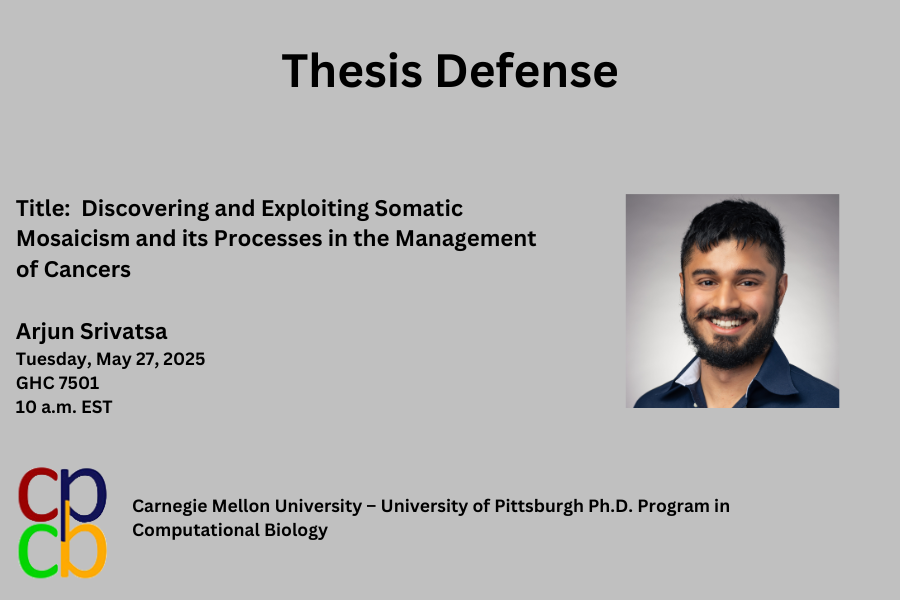
Thesis Defense: Arjun Srivatsa | May 27, 2025 | 10am
CBD and CPCB are proud to announce the following thesis defense:
Title: Discovering and Exploiting Somatic Mosaicism and its Processes in the Management of Cancers
Arjun Srivatsa
GHC 7501
10:00AM, EST
GHC 7501
10:00AM, EST
Committee:
Russell Schwartz, Chair, CMU
Carl Kingsford, CMU
Yu-Chih Chen, PITT
David Bartlett, AHN Cancer Institute
Abstract:
From conception until death, cells within the body undergo processes of somatic evolution in which cells accumulate mutations in particular genomic and spatial locations, in particular rates and types, and in various evolutionary patterns. Compared to the forces of Darwinian evolution shaping Earth's tree of life, the evolutionary patterns and processes shaping the mosaic of the human body differ in unique ways and are less well understood. Somatic evolution has mostly been studied within the realm of cancer biology, where tumors have been understood to arise from the accumulation of (epi)genetic modifications in normal cells. An understanding of how cancers arise and metastasize, as well as potential avenues of treatment through the oncological cycle of tumor formation, treatment, and relapse, hinges on computational and biotechnological tools for parsing information regarding a patient's somatic mutability. More recently, somatic mutability has been studied outside the cancer setting in normal tissue and various disease conditions, with studies finding key evolutionary processes in different parts of the aging human body, in human development, and in various diseases such as neurodegeneration and blood disorders.
A greater understanding of the processes of somatic evolution and how we might be able to detect and manipulate these processes in the management of disease will rely on principled experimental and computational frameworks to extract information, and also statistical and machine learning frameworks to evaluate this information with regard to risk and intervention. The main goal of this thesis is to pioneer a computational strategy by which researchers can probe the underlying somatic variability in normal and diseased tissues, then weigh the risk of these somatic landscapes under different somatic processes. We are particularly interested in finding and utilizing somatic mutability processes, that is, the intrinsic and extrinsic factors that generate population and evolutionary structure within tissue. The thesis proceeds in three main directions. In the first aim, we create a clonal evolution simulator, which allows us to create variable instances of somatic mosaicism and downstream data produced by biotechnological tools. In the second aim, we utilize this simulator along with an active learning optimization method to show that we can derive optimal study designs; this aim creates a machine learning algorithm that outputs viable biotechnology study designs when prompted with complex queries on information content within cell populations. The final work uses diverse tissue genomic data to mine somatic evolution processes, which is used in a machine learning study. We use statistical models to capture somatic lineage patterns that define clonal risk states and drive risk progression. Together, the thesis sets the foundation for the computational analysis of somatic landscapes, particularly within the novel areas of study design and clonal assessment tasks. Researchers will be able to choose principled study designs, assess risk throughout a clonal evolution, and choose intervention strategies that minimize this risk. We anticipate that the directions presented in this thesis can be furthered to design dynamic evolutionary strategies that create favorable somatic processes to manage cancer and other high-risk somatic states.